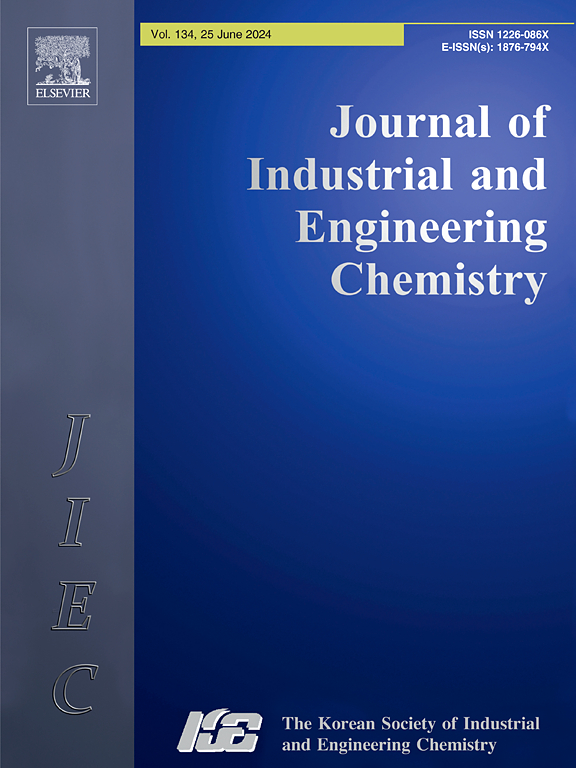利用乳清蛋白纳米生物材料进行组织再生和癌症治疗:最新创新的综合指南
IF 5.9
3区 工程技术
Q1 CHEMISTRY, MULTIDISCIPLINARY
Journal of Industrial and Engineering Chemistry
Pub Date : 2025-01-29
DOI:10.1016/j.jiec.2025.01.049
引用次数: 0
摘要
乳清蛋白(WPs)是最活跃的一类药物活性化合物。WPs具有较高的生物学价值,主要由α-La、β-Lg、LF和BSA等关键成分组成。WPs具有非免疫原性、生物相容性和可生物降解性,具有捕获和运输疏水物质的能力。除了增强免疫功能外,它们通常还表现出先进的功能特性,如乳化、凝胶化和高自由基清除潜力。从机制上讲,它们的亚组分由于能够调节IGF-1浓度而显示出成骨和抗癌潜力。转移性癌细胞阻碍细胞质v - atp酶活性的能力导致细胞内酸化和细胞外肿瘤微环境的碱化。此外,这些纳米载体系统具有独特的核壳结构,可以穿过细胞膜,提供相对简单的制造过程,并增加了负载能力。有效的纳米级WPs递送有望增加机械固定和支架功能,促进成骨分化和细胞增殖。这些特性为解开WPs纳米配方复杂的生物医学应用提供了有希望的途径。本文综述了wpp基纳米生物材料的组成、理化性质、生物来源和生产方法。这篇综述强调了这些成分在纳米生物技术中的治疗前景。本文章由计算机程序翻译,如有差异,请以英文原文为准。

Harnessing whey protein nanobiomaterials for tissue regeneration and cancer therapy: A comprehensive guide to recent innovations
Whey proteins (WPs) are the most actively flourishing class of pharmaceutically active compounds. WPs have high biological value and are dominated by crucial components such as α-La, β-Lg, LF and BSA. WPs, which are nonimmunogenic, biocompatible, and biodegradable, have the ability to entrap and transport hydrophobic substances. In addition to immune enhancement, they usually exhibit advanced functional properties such as emulsification, gelation, and high radical scavenging potential. Mechanistically, their subfractions display osteogenic and anticancer potential owing to their ability to modulate the IGF-1 concentration. The ability of metastatic cancer cells to impede plasmalemmal V-ATPase activity results in intracellular acidification and alkalization of the extracellular tumor microenvironment. Furthermore, these nanocarrier systems have an exclusive core-shell structure that can pass through the cell membrane and offer relatively simple manufacturing procedures, and increased loading capacity. The effective nanoscale delivery of WPs is expected to increase mechanical fixation and scaffold functionality and promote osteogenic differentiation and cell proliferation. These features offer promising avenues for unraveling the intricate biomedical applications of WPs nanoformulations. This review covers the composition, physicochemical properties, biological sources, and methods of production of WP-based nanobiomaterials. This review highlights the recent surge in the therapeutic prospects of these components in nanobiotechnology.
求助全文
通过发布文献求助,成功后即可免费获取论文全文。
去求助
来源期刊
CiteScore
10.40
自引率
6.60%
发文量
639
审稿时长
29 days
期刊介绍:
Journal of Industrial and Engineering Chemistry is published monthly in English by the Korean Society of Industrial and Engineering Chemistry. JIEC brings together multidisciplinary interests in one journal and is to disseminate information on all aspects of research and development in industrial and engineering chemistry. Contributions in the form of research articles, short communications, notes and reviews are considered for publication. The editors welcome original contributions that have not been and are not to be published elsewhere. Instruction to authors and a manuscript submissions form are printed at the end of each issue. Bulk reprints of individual articles can be ordered. This publication is partially supported by Korea Research Foundation and the Korean Federation of Science and Technology Societies.

 求助内容:
求助内容: 应助结果提醒方式:
应助结果提醒方式:


